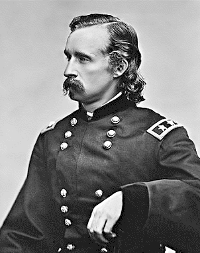On This Date In History
Custer's Plan - Heading To The Right
February 7, 2019
In a previous article, a fresh perspective on Custer's overall Little Bighorn plan was presented. This overall Little Bighorn plan, being different from what is typically presented as his plan, allows for the battle of the Little Bighorn to be looked at in a whole new light - it allows for various aspects of the battle to be re-analyzed and re-interpreted. One such aspect of the battle that can now be re-interpreted is Custer's decision to head to the right of the Indian camp.
On June 25th, 1876, as General Custer headed northward toward the Little Bighorn River, he believed he was in the vicinity of the Sioux. About a mile from the Little Bighorn River, he received word that Indians were spotted straight ahead and running. Previously, he had sent Captain Benteen to the left. Now, it was only his and Reno's battalions that were heading together toward the Indians.
Custer would direct Reno to continue to head northward straight toward the Indians and engage them. Custer and his battalion would continue northward as well until making a turn to the right and heading down the east side of the Little Bighorn river - to the right of the Indian encampment.
Upon reaching a point at which he could see the Indian camp, Custer sent orders back to Captain Benteen and then continued heading northward down the east side of the Little Bighorn River, to the right of the Indian encampment. His movement northward would eventually come to an end and he would be defeated in battle.
Since Custer decided to head to the right of the Indian camp that day, his decision has been analyzed, interpreted, and questioned. To this day, people have continued to wonder why he made that decision.
While some explanations have been provided for why Custer decided to make that movement, the matter seems to have remained somewhat of a mystery. Now, in light of Custer's overall Little Bighorn plan, an answer may finally be available.
Custer's decision to head to the right seems to be best explained when examined in light of his overall Little Bighorn plan: to move the Sioux north toward the Yellowstone River. As the Indians were reported to be on the move, and the implication of the report being that they were headed northward away from Custer, it appears that his movement to the right was done in order to keep them headed north by preventing them from crossing the river and heading east.
Since Custer's movement to the right on that day so long ago, it appears to have been seen as somewhat mysterious. While attempts have been made to solve this mystery, it looks like it makes the most sense as being part of his overall plan to move the Indians north toward the Yellowstone River.
About the Author
Tim Kloos is an online advertising professional. He helps clients with their websites, online presence, and online advertising. If you need help with any of these, feel free to contact him via the contact page.
His tech website is clevelandwebdesignplus.com.
He has also written a children's book set in the Old West.
